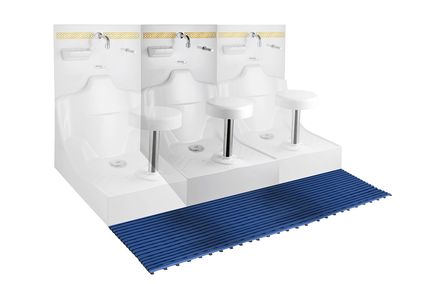Photos Patrick Bingham-Hall



Departure lounge design has two priorities. It attempts to allay the anxiety of air travel – muted tones and muzak are thought to assuage the ambient fear of flying – and it is bound to produce a legible class structure through, among other things, the purchase of artworks. This need to signify social stratification, combined with the vapid palette of materials employed to soothe the prospective traveller, could not be said to form the most fertile basis for interesting design.
These challenges were presented to artist Janet Laurence in the creation of her new installation for the Qantas Club business lounge at the Sydney Airport international terminal. Entitled translucidis (a thin cloud through which the sun and moon are visible) the work comprises two back-lit horizontal sequences of layered glass panes, depicting different types of cloud formations, arranged on both sides of a partition that separates the lounge from the cafe.
Images of cloud types sourced from the Bureau of Meteorology are fixed to some panels while others contain emissions and spillages of paint arrested between glass – like samples squeezed between the plates of a microscope. Interestingly, Qantas refused the use of images of storm clouds in the work, no doubt thinking that this exclusion would encourage travellers to look upon clouds as benign objects that billow past the cabin window, not as potential generators of turbulence. Along one of the sequences, large grey script spells out the names of the cloud types represented. The tension between the textual classification and the ephemeral subject is potent and skilfully manipulated through the cropping and colouring of the images.
The cloud is a partially formless and certainly surface-less phenomenon and, as such, does not readily submit to clear categorisation. As the art historian Hubert Damisch points out, the cloud posed significant problems during the development of perspective drawing. Unlocalisable and immeasurable, the cloud could not be described by the co-ordinate geometry of perspectival logic. The perspectival scene therefore depends on an “unrepresentable” element in order to constitute its pictorial cohesion. Meteorologists have now developed systems for describing the properties of clouds, however one expects that these classifications are delightfully fluid – and Laurence’s piece bears this out.
In translucidis, the categorical porosity of the classification system is represented through a co-ordination of layered images that tend to bleed into one another. Although the piece suffers from poor lighting during the day, when glare brings the glass surface, particularly the edges, into strong relief and obscures the delicacy and texture of the images, closer inspection of the work is rewarded. The layering of images produces subtle moire effects that momentarily dissolve one’s sense of the overly heavy panels. The surface is lost, thickening and shimmering; putting the cloud as effect, not just as representation, into operation in the work.
With translucidis Laurence has aimed to “create a sublime continuous floating sensation based on an elemental theme”, through a “weaving between, of layers of glass, as veils, creating varying degrees of transparency and translucency”. This effect can certainly be found here, but perhaps not quite where the artist had intended. The minor disruptions to the integrity of the picture plane, caused by the printing process, deny the materiality of the glass and provide the spatial ambiguity the artist seeks and therefore they beg further exploration.
On a conceptual level the piece is very evocative and rich and it has formed the foundation for much of Laurence’s subsequent work. On the basis of translucidis, this will be much anticipated.
Adrian Lahoud is a Sydney-based architect















